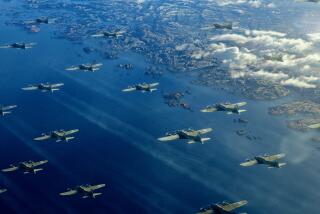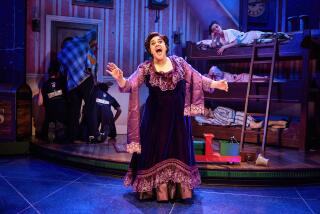Peter Foy, 79; Master of Stage Flight Sent “Peter Pan” Soaring
“First, I must blow the fairy dust on you,” Peter Pan, the boy who never grew up, tells the Darling children the first time he guides them aloft. Flying is so easy that there is only one other thing they must do: “Think lovely thoughts.”
Peter Foy understood the lovely thoughts. You could read them on his gleaming face when he operated the ropes, wires and pulleys that sent Mary Martin soaring over a Broadway stage in the 1954 musical version of “Peter Pan,” the J.M. Barrie classic. Foy was the master of stage flight -- “aerography,” he called it -- who perfected the mechanisms that enabled Martin’s signature flight and those of countless others. He was the technical wizard who sent more Peter Pans on their magical journeys than anyone else in his unusual business.
Foy was the founder of Flying by Foy, a 48-year-old company that specializes in theatrical flying effects. The transplanted Englishman died Feb. 17 of natural causes in Las Vegas, his home for the last four decades. He was 79.
His machines flew just about all the notable Peter Pans, from Jean Arthur and Martin to Sandy Duncan and Cathy Rigby, as well as most of the less-famous ones. He stopped counting at 6,000 productions worldwide.
He also worked in television and film, rigging up the aerial antics of stars such as Dean Martin, Bob Hope, Jack Benny, Lucille Ball and Jerry Lewis. He launched Sally Field on television’s “The Flying Nun” and hosts of angels in the annual Christmas pageant at the Crystal Cathedral. Asked by a director if he could haul two people in a sleigh through the air for a production of “Nutcracker,” Foy replied, “Lady, I flew out Liberace and his piano.”
In a risky business, his flubs were astonishingly few. One time, the flamboyant Liberace was dragged instead of flown offstage when an inept technician was at the controls. On another occasion, Foy’s assistant was so mesmerized by the sight of Peter Pan in flight that he forgot what he was doing and sailed Martin right into a brick wall.
Martin wound up with a broken arm but returned to the set the same day.
“I never knew how all the mechanics of harness, hoist and pulley worked,” she wrote in “My Heart Belongs,” her 1976 memoir. “I simply trusted them and Peter Foy.”
Foy “was absolutely the top man in the field,” said Miles Kreuger, president of the Institute of the American Musical. “He was celebrated in the theater as the leading practitioner ... of making actors fly.”
Born in London to a theatrical family -- his mother was a famous soubrette, his father a comedian -- Foy had Peter Pan fantasies as a child. While some children walked in their sleep, he tried to soar. His mother would find him later in a heap on the floor and wonder how he got there. “I was flying,” he would reply.
Given such lofty preoccupations, it was natural that, at 14, Foy found himself suspended from a slim steel wire playing a sea witch in a London production of “Where the Rainbow Ends.” When the stage manager fell ill, young Foy took over his duties, which included overseeing all the flying actors.
During World War II, he flew for real as a navigator and entertainment officer in the Royal Air Force. After the war, he found work with Kirby’s Flying Ballets, the British company that had helped all the Peter Pans in England take wing.
In 1950, when the producers of “Peter Pan” on Broadway discovered that virtually no theatrical flying had been performed in the United States for 20 years, they turned to Kirby’s Flying Ballets. The company sent Foy to New York to direct flying for the show, which starred Jean Arthur as Peter Pan and Boris Karloff as Captain Hook.
A problem-solver by nature, Foy began to experiment with Kirby’s equipment. In 1954, when Kirby’s assigned him to work on the musical incarnation of “Peter Pan,” Martin challenged him to stretch the limits of the art.
“No Peter Pan had ever flown very far -- just through the window of the stage set, over to the mantelpiece, around the room and back out the window,” she wrote. “I was determined ... to fly all over the place. I wanted to fly at least 60 feet across the stage.... I also wanted a flying ballet with Peter and the children -- Wendy, Michael and John -- all sailing around together. Peter Foy sort of gulped, but he agreed to try.”
He came up with a device called the Inter-related Pendulum that not only allowed dynamic movement back and forth over the stage but also launched actors higher, faster and more smoothly than before.
“Now you had control of the performer all the time. You could design the flight. That changed everything,” said Bill Sapsis, who worked with Foy before starting his own theatrical rigging company in Philadelphia.
Foy’s technical virtuosity and Martin’s athleticism and grace combined to produce a definitive performance that brought critical raves.
“You can believe in this Peter Pan,” Los Angeles Times reviewer Albert Goldberg wrote when Martin, in a pre-Broadway run, performed the title role for the Los Angeles Civic Light Opera. “He -- or she -- flies recklessly and breathtakingly through the air as if she had been tutored by angels.”
Foy’s next advance came in 1958, after he had left Kirby’s to start his own business. He developed the floating pulley, a device that enabled flying in theaters with ceilings lower than 40 feet. The only problem was that it was often visible to the audience, so in 1962 he invented an entirely new system that not only could operate out of sight of theatergoers but could also allow more daring and creative flight because two operators could independently lift and pull actors over the stage.
“That was the real breakthrough,” said Joe McGeough, Foy’s son-in-law and president of Foy Inventerprises, the umbrella company for Flying by Foy. “It was ... a very simple, brilliant little piece of equipment,” still widely used today.
Foy also developed a special harness for “Fantastic Voyage,” the 1965 science fiction movie that starred Raquel Welch and Donald Pleasence as miniaturized scientists injected into the bloodstream of a dying man. The harness, which allowed the actors to fly in a horizontal position that better simulated the act of swimming through the body, contributed to the movie’s Academy Award for special visual effects.
In 1984, Foy was reunited with Martin when she decided to re-create part of her Peter Pan role as the finale for a benefit concert in San Francisco. The veteran aerographer, dressed in his usual natty blue blazer and gray flannel slacks, propelled the then-septuagenarian actress 70 feet over a rapt audience at Davies Symphony Hall. Stardust drifted down as she flew.
The enchantment of such moments transformed Foy.
“He had a big demonic grin on his face,” said James Hansen, Foy Inventerprises’ general manager, recalling the time many years ago when he climbed high above the stage during a production of “Peter Pan” to watch the master work his flying equipment.
“His face had opened up and rays shot out of it. It was euphoric, intense, joyous and insane all at the same time. If you never saw Peter Foy operating, it was an amazing thing to watch. It was what he loved most.”
Foy is survived by his wife, Barbara; a son, Garry; a daughter, Teresa McGeough; and two grandchildren.
More to Read
The biggest entertainment stories
Get our big stories about Hollywood, film, television, music, arts, culture and more right in your inbox as soon as they publish.
You may occasionally receive promotional content from the Los Angeles Times.











